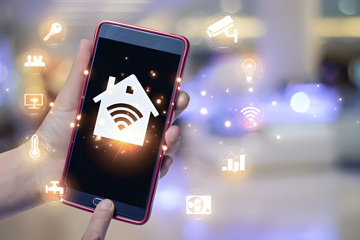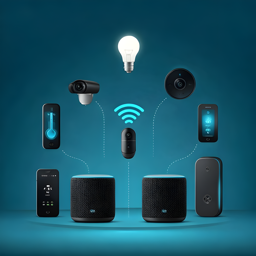LoRaWAN IoT Gateway: ESP32 and Raspberry Pi Setup Tutorial
ESP32 LoRa & TTN: Ultimate IoT Sensor Data Guide 2023
LoRa (Long Range) is a popular choice for IoT applications requiring long-distance communication with low power consumption Zigbee Green Power: Ultra-Low-Power Energy Harvesting SolutionsDiscover how ZGP enables battery-free IoT devices through energy harvesting with ESP32 integrations, supporting smart home and industrial applications.. When combined with The Things Network (TTN), a global, open LoRaWAN network, it becomes a powerful tool for transmitting sensor data over vast distances. This guide focuses on transmitting sensor data from ESP32-based nodes to The Things Network (TTN), covering hardware setup
Zigbee Green Power: Ultra-Low-Power Energy Harvesting SolutionsDiscover how ZGP enables battery-free IoT devices through energy harvesting with ESP32 integrations, supporting smart home and industrial applications.. When combined with The Things Network (TTN), a global, open LoRaWAN network, it becomes a powerful tool for transmitting sensor data over vast distances. This guide focuses on transmitting sensor data from ESP32-based nodes to The Things Network (TTN), covering hardware setup Zigbee Green Power: Ultra-Low-Power Energy Harvesting SolutionsDiscover how ZGP enables battery-free IoT devices through energy harvesting with ESP32 integrations, supporting smart home and industrial applications., TTN configuration, payload encoding, and real-world deployment strategies.
Zigbee Green Power: Ultra-Low-Power Energy Harvesting SolutionsDiscover how ZGP enables battery-free IoT devices through energy harvesting with ESP32 integrations, supporting smart home and industrial applications., TTN configuration, payload encoding, and real-world deployment strategies.
Table of Contents🔗
1. Introduction to LoRa ESP32 Multi-Protocol Gateways: Combining Wi-Fi, BLE, and LoRaDiscover how to build a multi-protocol ESP32 gateway integrating Wi-Fi, BLE, and LoRa for scalable IoT deployments in smart cities and industry. and TTN
ESP32 Multi-Protocol Gateways: Combining Wi-Fi, BLE, and LoRaDiscover how to build a multi-protocol ESP32 gateway integrating Wi-Fi, BLE, and LoRa for scalable IoT deployments in smart cities and industry. and TTN
2. Hardware Setup Zigbee Green Power: Ultra-Low-Power Energy Harvesting SolutionsDiscover how ZGP enables battery-free IoT devices through energy harvesting with ESP32 integrations, supporting smart home and industrial applications.: LoRa Modules and ESP32
Zigbee Green Power: Ultra-Low-Power Energy Harvesting SolutionsDiscover how ZGP enables battery-free IoT devices through energy harvesting with ESP32 integrations, supporting smart home and industrial applications.: LoRa Modules and ESP32
3. Configuring TTN Applications and Devices
4. OTAA vs. ABP Activation Methods
5. Payload Encoding for Sensor Data Sigfox Message Encoding: Packing Sensor Data into 12-byte PayloadsLearn efficient data encoding techniques for Sigfox's constrained 12-byte payloads. Discover bitwise operations, structured encoding & CBOR strategies.
Sigfox Message Encoding: Packing Sensor Data into 12-byte PayloadsLearn efficient data encoding techniques for Sigfox's constrained 12-byte payloads. Discover bitwise operations, structured encoding & CBOR strategies.
6. End-to-End Example: Temperature/Humidity Node
7. Troubleshooting Common Issues Zigbee Over-the-Air (OTA) Firmware Updates with ESP32 CoordinatorsSecure your IoT network with OTA firmware upgrades using an ESP32 coordinator. Our guide details firmware setup, packaging, security, and troubleshooting.
Zigbee Over-the-Air (OTA) Firmware Updates with ESP32 CoordinatorsSecure your IoT network with OTA firmware upgrades using an ESP32 coordinator. Our guide details firmware setup, packaging, security, and troubleshooting.
Introduction to LoRa and TTN🔗
LoRa is a wireless communication technology designed for low-power, long-range Quick Comparison: Range, power consumption, costs, and complexity of each technologyDiscover the ideal wireless solution for your ESP32 IoT project by analyzing range, power, cost, and complexity. Optimize connectivity now. communication. It operates in sub-GHz ISM bands (e.g., 868 MHz in Europe, 915 MHz in the US) and uses chirp spread spectrum modulation to achieve robust communication even in noisy environments.
Quick Comparison: Range, power consumption, costs, and complexity of each technologyDiscover the ideal wireless solution for your ESP32 IoT project by analyzing range, power, cost, and complexity. Optimize connectivity now. communication. It operates in sub-GHz ISM bands (e.g., 868 MHz in Europe, 915 MHz in the US) and uses chirp spread spectrum modulation to achieve robust communication even in noisy environments.
The Things Network (TTN) is a global, community-driven LoRaWAN network that allows devices to send and receive data over LoRa. It provides a scalable and cost-effective solution for IoT applications, from environmental monitoring Connecting ESP32 to Cloud Services via Wi-FiDiscover how to connect your ESP32 to AWS, Azure, and Google Cloud using secure Wi-Fi. This guide covers setup, error handling, and low power strategies. to asset tracking.
Connecting ESP32 to Cloud Services via Wi-FiDiscover how to connect your ESP32 to AWS, Azure, and Google Cloud using secure Wi-Fi. This guide covers setup, error handling, and low power strategies. to asset tracking.
Key Points:
- Long-Range
 Quick Comparison: Range, power consumption, costs, and complexity of each technologyDiscover the ideal wireless solution for your ESP32 IoT project by analyzing range, power, cost, and complexity. Optimize connectivity now. Communication: Ideal for remote sensors and rural deployments.
Quick Comparison: Range, power consumption, costs, and complexity of each technologyDiscover the ideal wireless solution for your ESP32 IoT project by analyzing range, power, cost, and complexity. Optimize connectivity now. Communication: Ideal for remote sensors and rural deployments. - Low Power Consumption
 Zigbee Green Power: Ultra-Low-Power Energy Harvesting SolutionsDiscover how ZGP enables battery-free IoT devices through energy harvesting with ESP32 integrations, supporting smart home and industrial applications.: Makes battery-powered sensor nodes a reality.
Zigbee Green Power: Ultra-Low-Power Energy Harvesting SolutionsDiscover how ZGP enables battery-free IoT devices through energy harvesting with ESP32 integrations, supporting smart home and industrial applications.: Makes battery-powered sensor nodes a reality. - Scalability: TTN provides a scalable backend suitable for small and large IoT applications
 Connecting ESP32 to Cloud Services via Wi-FiDiscover how to connect your ESP32 to AWS, Azure, and Google Cloud using secure Wi-Fi. This guide covers setup, error handling, and low power strategies..
Connecting ESP32 to Cloud Services via Wi-FiDiscover how to connect your ESP32 to AWS, Azure, and Google Cloud using secure Wi-Fi. This guide covers setup, error handling, and low power strategies..
Hardware Setup: LoRa Modules and ESP32🔗
To use LoRa with the ESP32 Setting Up ESP32 as a Wi-Fi Access PointMaster ESP32 AP configuration with our step-by-step guide. Set up a secure, local IoT network using practical code examples and optimization tips., you’ll need an external LoRa module like the SX1276 or SX1262. These modules communicate with the ESP32 via SPI or UART. Here’s a basic wiring
Setting Up ESP32 as a Wi-Fi Access PointMaster ESP32 AP configuration with our step-by-step guide. Set up a secure, local IoT network using practical code examples and optimization tips., you’ll need an external LoRa module like the SX1276 or SX1262. These modules communicate with the ESP32 via SPI or UART. Here’s a basic wiring Using Quectel BC66/BG96 Modules with ESP32 for NB-IoT ConnectivityExplore our detailed tutorial on integrating Quectel BC66/BG96 with ESP32 for low-power, reliable NB-IoT connectivity. Learn hardware setup and AT commands. guide for SPI:
Using Quectel BC66/BG96 Modules with ESP32 for NB-IoT ConnectivityExplore our detailed tutorial on integrating Quectel BC66/BG96 with ESP32 for low-power, reliable NB-IoT connectivity. Learn hardware setup and AT commands. guide for SPI:
| ESP32 Pin | LoRa Module Pin |
|---|---|
| 3.3V | VCC |
| GND | GND |
| GPIO5 (SCK) | SCK |
| GPIO19 (MISO) | MISO |
| GPIO27 (MOSI) | MOSI |
| GPIO18 (CS) | NSS |
| GPIO14 (RST) | RST |
| GPIO26 (DIO0) | DIO0 |
Note: Ensure the LoRa ESP32 Multi-Protocol Gateways: Combining Wi-Fi, BLE, and LoRaDiscover how to build a multi-protocol ESP32 gateway integrating Wi-Fi, BLE, and LoRa for scalable IoT deployments in smart cities and industry. module is powered with 3.3V, as most modules are not 5V tolerant.
ESP32 Multi-Protocol Gateways: Combining Wi-Fi, BLE, and LoRaDiscover how to build a multi-protocol ESP32 gateway integrating Wi-Fi, BLE, and LoRa for scalable IoT deployments in smart cities and industry. module is powered with 3.3V, as most modules are not 5V tolerant.
Example Initialization with Arduino-LoRa ESP32 Multi-Protocol Gateways: Combining Wi-Fi, BLE, and LoRaDiscover how to build a multi-protocol ESP32 gateway integrating Wi-Fi, BLE, and LoRa for scalable IoT deployments in smart cities and industry. Library:
ESP32 Multi-Protocol Gateways: Combining Wi-Fi, BLE, and LoRaDiscover how to build a multi-protocol ESP32 gateway integrating Wi-Fi, BLE, and LoRa for scalable IoT deployments in smart cities and industry. Library:
#include <SPI.h>
#include <LoRa.h>
void setup() {
LoRa.setPins(5, 2, 14); // NSS, RST, DIO0
if (!LoRa.begin(915E6)) {
Serial.println("LoRa init failed!");
while (1);
}
Serial.println("LoRa initialized.");
}
Configuring TTN Applications and Devices🔗
1. Create a TTN Application:
- Log in to TTN Console.
- Navigate to Applications → Create Application.
2. Register Your Device:
- Under your application, go to End Devices → Add End Device.
- Select Manual registration.
- Enter JoinEUI, DevEUI, and AppKey (for OTAA).
OTAA vs. ABP Activation Methods🔗
| Feature | OTAA (Over-the-Air Activation) | ABP (Activation by Personalization) |
|---|---|---|
| Security | Dynamic session keys | Static session keys |
| Network Flexibility | Allows roaming | Device tied to a single network |
| Recommended Use | Production deployments | Testing/development |
OTAA Code Snippet (Using MCCI LMIC Library):
#include <lmic.h>
void os_getArtEui (u1_t* buf) { memcpy_P(buf, APPEUI, 8); }
void os_getDevEui (u1_t* buf) { memcpy_P(buf, DEVEUI, 8); }
void os_getDevKey (u1_t* buf) { memcpy_P(buf, APPKEY, 16); }
void onEvent (ev_t ev) {
if (ev == EV_JOINED) {
Serial.println("Joined TTN!");
}
}
Payload Encoding for Sensor Data🔗
Sensor data Sigfox Message Encoding: Packing Sensor Data into 12-byte PayloadsLearn efficient data encoding techniques for Sigfox's constrained 12-byte payloads. Discover bitwise operations, structured encoding & CBOR strategies. is usually transmitted as a binary payload. This approach conserves bandwidth, which is crucial given the limited payload sizes in LoRaWAN (often around 12–51 bytes, depending on data rate).
Sigfox Message Encoding: Packing Sensor Data into 12-byte PayloadsLearn efficient data encoding techniques for Sigfox's constrained 12-byte payloads. Discover bitwise operations, structured encoding & CBOR strategies. is usually transmitted as a binary payload. This approach conserves bandwidth, which is crucial given the limited payload sizes in LoRaWAN (often around 12–51 bytes, depending on data rate).
Example: Sending Temperature and Humidity
struct SensorData {
float temp;
float humidity;
uint16_t battery;
};
void sendData() {
SensorData data = {25.3, 65.2, 3450};
LoRa.beginPacket();
LoRa.write((uint8_t*)&data, sizeof(data));
LoRa.endPacket();
}
TTN Payload Sigfox Message Encoding: Packing Sensor Data into 12-byte PayloadsLearn efficient data encoding techniques for Sigfox's constrained 12-byte payloads. Discover bitwise operations, structured encoding & CBOR strategies. Decoder (JavaScript):
Sigfox Message Encoding: Packing Sensor Data into 12-byte PayloadsLearn efficient data encoding techniques for Sigfox's constrained 12-byte payloads. Discover bitwise operations, structured encoding & CBOR strategies. Decoder (JavaScript):
function decodeUplink(bytes) {
return {
temperature: bytesToFloat(bytes.slice(0, 4)),
humidity: bytesToFloat(bytes.slice(4, 8)),
battery: (bytes[8] << 8) | bytes[9]
};
}
End-to-End Example: Temperature/Humidity Node🔗
Steps:
1. Read data from a sensor (e.g., DHT22).
2. Encode payload Sigfox Message Encoding: Packing Sensor Data into 12-byte PayloadsLearn efficient data encoding techniques for Sigfox's constrained 12-byte payloads. Discover bitwise operations, structured encoding & CBOR strategies. using CBOR or byte packing.
Sigfox Message Encoding: Packing Sensor Data into 12-byte PayloadsLearn efficient data encoding techniques for Sigfox's constrained 12-byte payloads. Discover bitwise operations, structured encoding & CBOR strategies. using CBOR or byte packing.
4. Monitor data in TTN Console.
Full Code:
#include <LoRa.h>
#include <CayenneLPP.h>
CayenneLPP lpp(51);
void loop() {
float temp = readTemperature();
float humidity = readHumidity();
lpp.reset();
lpp.addTemperature(1, temp);
lpp.addRelativeHumidity(2, humidity);
LoRa.beginPacket();
LoRa.write(lpp.getBuffer(), lpp.getSize());
LoRa.endPacket();
delay(300000); // Send every 5 minutes
}
Troubleshooting Common Issues🔗
1. No Join Response (OTAA):
- Ensure the App Key and EUIs are correct.
- Check if the device is within range of a TTN gateway
 ESP32 Multi-Protocol Gateways: Combining Wi-Fi, BLE, and LoRaDiscover how to build a multi-protocol ESP32 gateway integrating Wi-Fi, BLE, and LoRa for scalable IoT deployments in smart cities and industry..
ESP32 Multi-Protocol Gateways: Combining Wi-Fi, BLE, and LoRaDiscover how to build a multi-protocol ESP32 gateway integrating Wi-Fi, BLE, and LoRa for scalable IoT deployments in smart cities and industry..
- Adjust the spreading factor
 Adaptive Data Rate (ADR) Optimization for LoRaWAN on ESP32Optimize your IoT network with our ADR tutorial for ESP32 in LoRaWAN. Learn dynamic transmission tuning, power management, and troubleshooting strategies. and bandwidth.
Adaptive Data Rate (ADR) Optimization for LoRaWAN on ESP32Optimize your IoT network with our ADR tutorial for ESP32 in LoRaWAN. Learn dynamic transmission tuning, power management, and troubleshooting strategies. and bandwidth. - Ensure the antenna is properly connected and positioned.
- Verify the LoRa
 ESP32 Multi-Protocol Gateways: Combining Wi-Fi, BLE, and LoRaDiscover how to build a multi-protocol ESP32 gateway integrating Wi-Fi, BLE, and LoRa for scalable IoT deployments in smart cities and industry. module is powered correctly.
ESP32 Multi-Protocol Gateways: Combining Wi-Fi, BLE, and LoRaDiscover how to build a multi-protocol ESP32 gateway integrating Wi-Fi, BLE, and LoRa for scalable IoT deployments in smart cities and industry. module is powered correctly. - Check for SPI/UART communication
 Interfacing ESP32 with Zigbee3.0 Devices (Xiaomi, Philips Hue)Unlock seamless smart home integration by following our detailed guide on bridging ESP32 with external Zigbee modules for reliable IoT solutions. issues.
Interfacing ESP32 with Zigbee3.0 Devices (Xiaomi, Philips Hue)Unlock seamless smart home integration by following our detailed guide on bridging ESP32 with external Zigbee modules for reliable IoT solutions. issues.
- LoRaWAN limits payload
 Sigfox Message Encoding: Packing Sensor Data into 12-byte PayloadsLearn efficient data encoding techniques for Sigfox's constrained 12-byte payloads. Discover bitwise operations, structured encoding & CBOR strategies. size (e.g., 51 bytes for DR0). Use CayenneLPP for efficient encoding.
Sigfox Message Encoding: Packing Sensor Data into 12-byte PayloadsLearn efficient data encoding techniques for Sigfox's constrained 12-byte payloads. Discover bitwise operations, structured encoding & CBOR strategies. size (e.g., 51 bytes for DR0). Use CayenneLPP for efficient encoding.
5. Downlink Failures:
- Ensure device is in receive mode after uplink.
- Configure RX1/RX2 windows in firmware.
Final Thoughts🔗
LoRaWAN and TTN simplify long-range IoT deployments. For scalable solutions Zigbee Green Power: Ultra-Low-Power Energy Harvesting SolutionsDiscover how ZGP enables battery-free IoT devices through energy harvesting with ESP32 integrations, supporting smart home and industrial applications.:
Zigbee Green Power: Ultra-Low-Power Energy Harvesting SolutionsDiscover how ZGP enables battery-free IoT devices through energy harvesting with ESP32 integrations, supporting smart home and industrial applications.:
- Use OTAA for production.
- Optimize payloads for energy efficiency.
- Monitor signal quality
 SIM7000G Module with ESP32: Configuring LTE-M and GNSSMaster ESP32 integration with SIM7000G for reliable LTE-M connectivity and precise GPS tracking, featuring hardware setup, AT commands, and power tips. using TTN’s built-in metrics.
SIM7000G Module with ESP32: Configuring LTE-M and GNSSMaster ESP32 integration with SIM7000G for reliable LTE-M connectivity and precise GPS tracking, featuring hardware setup, AT commands, and power tips. using TTN’s built-in metrics.
By understanding and implementing these elements-from hardware wiring to payload management-you can confidently deploy efficient and secure LoRa sensor nodes that relay data to TTN for diverse IoT applications Connecting ESP32 to Cloud Services via Wi-FiDiscover how to connect your ESP32 to AWS, Azure, and Google Cloud using secure Wi-Fi. This guide covers setup, error handling, and low power strategies.. Happy coding and may your sensor nodes reach far and wide!
Connecting ESP32 to Cloud Services via Wi-FiDiscover how to connect your ESP32 to AWS, Azure, and Google Cloud using secure Wi-Fi. This guide covers setup, error handling, and low power strategies.. Happy coding and may your sensor nodes reach far and wide!
Author: Marcelo V. Souza - Engenheiro de Sistemas e Entusiasta em IoT e Desenvolvimento de Software, com foco em inovação tecnológica.
References🔗
- Arduino Forum: forum.arduino.cc
- Arduino IDE Official Website: arduino.cc
- ESP-IDF Programming Guide: docs.espressif.com/projects/esp-idf
- ESP32 Arduino Core Documentation: docs.espressif.com/projects/arduino-esp32
- Espressif Documentation: docs.espressif.com

 7 months ago
7 months ago
 7 months ago
7 months ago
 7 months ago
7 months ago
 7 months ago
7 months ago
 7 months ago
7 months ago
 7 months ago
7 months ago
 7 months ago
7 months ago
 8 months ago
8 months ago
 7 months ago
7 months ago
 7 months ago
7 months ago
 7 months ago
7 months ago
 7 months ago
7 months ago
 7 months ago
7 months ago
 7 months ago
7 months ago
 7 months ago
7 months ago
 7 months ago
7 months ago
 7 months ago
7 months ago
 7 months ago
7 months ago
 7 months ago
7 months ago
 7 months ago
7 months ago
 7 months ago
7 months ago
 7 months ago
7 months ago
 7 months ago
7 months ago
 7 months ago
7 months ago